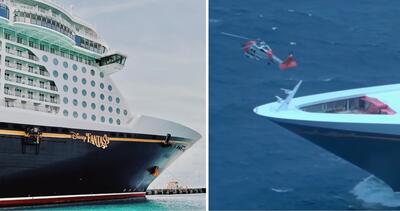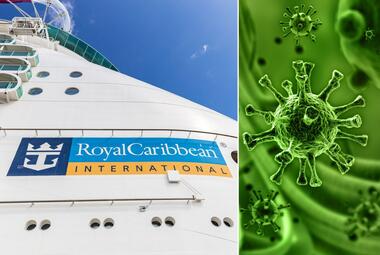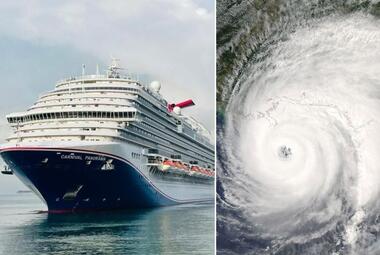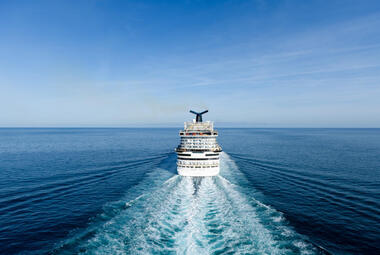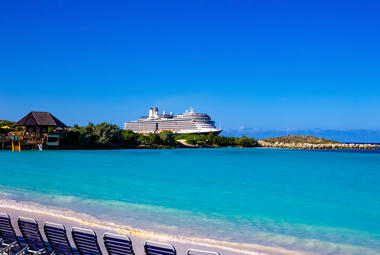A 35-year-old pregnant woman was medically evacuated from the Disney Fantasy this week when she started experiencing pregnancy-related health complications. The passenger was sailing on a 7-night Eastern Caribbean cruise on the Disney Fantasy when the complications began.
In a press release from the US Coast Guard, the department shared how two aircraft conducted a long-range medical evacuation from the Disney Fantasy cruise ship on Monday, April 15, while the ship was in transit. The Disney Fantasy departed on April 13 from Port Canaveral with scheduled stops in Tortola, St. Thomas, and Disney’s Castaway Cay in the Bahamas.
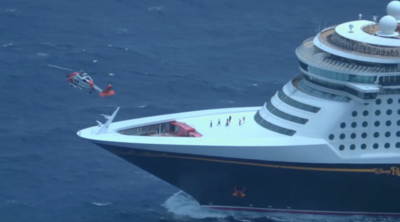
It was not announced how many weeks pregnant the passenger was while cruising on the Disney Fantasy. Pregnant passengers are required to be 23 weeks or earlier while cruising. The Coast Guard shared that the passenger was a U.S. citizen who required a higher level of medical care ashore due to health complications. The pregnant woman was evacuated alongside the cruise ship doctor to a hospital in Puerto Rico.
The rescue was a joint effort between Coast Guard crews in both Puerto Rico and Miami, Florida.
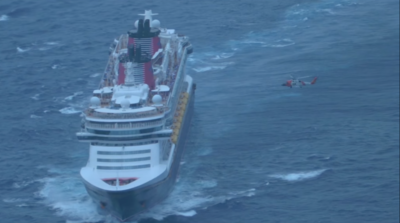
According to the Coast Guard, a Jayhawk MH-60 helicopter from the Coast Guard Air Station Borinquen in Puerto Rico and an HC-144 Ocean Sentry aircrew from the Coast Guard Air Station Miami successfully evacuated the pregnant woman from the Disney Fantasy.
“We are glad everything came together to help this passenger. The competency displayed by the Disney Fantasy crew and the Coast Guard personnel and units involved made all the difference,” said Ensign Michael Riccio, Coast Guard Sector San Juan operations unit leader.
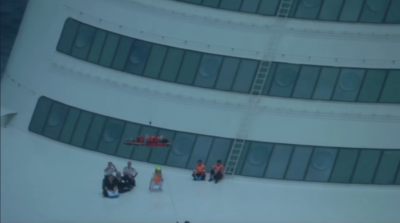
The aircraft were sent to the Disney Fantasy while the ship was 180 miles northwest of Puerto Rico. Once the Ocean Sentry aircraft arrived to the cruise ship, the Jawhark aircrew deployed their rescue swimmer to the vessel. The aircrew member was able to prepare the rescue basket and safely hoist the patient and cruise ship doctor aboard the aircraft.
Once ashore, the passenger was transported to a local hospital in San Juan by local emergency medical service personnel. Footage of the rescue was shared by the US Coast Guard on X, showing the passenger being transported by stretcher to the bow of the Disney Fantasy. The pregnant passenger can be seen as she is airlifted from the vessel into the Jayhawk helicopter in the rescue basket.

The passenger’s current condition has not been reported other than she is receiving medical care from the Centro Medico Hospital in San Juan, Puerto Rico.
The scary incident at sea highlights the health risks of cruising while pregnant.

Every major cruise line has the same policy when it comes to pregnant women. Pregnant women are not banned from cruising; however, all major cruise lines only allow pregnant women to sail through their 23rd week of pregnancy.
Pregnant women must be 23 weeks or less for the entire duration of your cruise. This means if you enter your 24th week of pregnancy during the cruise, you aren't allowed to sail. Most cruise lines will require passengers to attest whether they are pregnant or not in their health questionnaire prior to boarding.
Depending on the cruise line, you might be required to provide a letter from your doctor regarding your condition to cruise and the anticipated due date. If you have a healthy pregnancy and receive approval from your doctor, most pregnant women are able to successfully cruise.
The cruising regulation for pregnant passengers is established due to the baby’s viability, based on gestational age. In the U.S., a fetus is considered viable at 24 weeks. This means if the pregnant mother goes into preterm labor, the baby could survive with proper medical intervention. Prior to 24 weeks, preterm labor is largely due to miscarriage rather than delivering a viable, premature newborn.

While cruise ship medical facilities are robust, they are not equipped to handle the proper care for a premature baby. As such, the pregnancy policies are in place to help minimize the chance of women going into premature labor and delivering a baby that requires complex medical care. Essentially, a cruise ship does not have a NICU onboard to care for an extremely premature baby.
Typically, a cruise ship has at least one licensed doctor and two nurses onboard. However, larger ships normally sail with two doctors onboard and up to four nurses. The medical staff are available 24 hours each day of a cruise.
Even though the medical professionals are trained to handle emergencies and perform life-saving measures when needed, the medical center is not a hospital. If an ill passenger requires more specialized care, the patient will be medically disembarked usually at the next port of call. More dire situations, such as the incident on the Disney Fantasy, can require medical evacuation by helicopter.
Even still, cruising while pregnant is not without inherent risks.
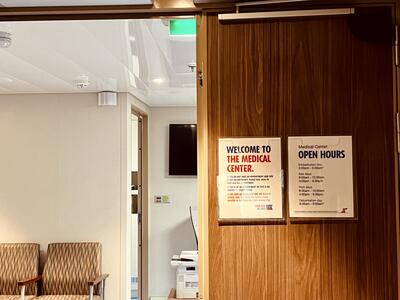
Because of the nature of cruising, the ship will be away from land, sailing to and from each port of call. While at sea, that means pregnant women will only have access to the medical care provided onboard the cruise ship in an emergency.
In addition to pregnancy-related risks, pregnant women should also consider the increased exposure to illnesses while onboard a cruise ship. Given close living quarters, communicable diseases can spread quickly on a ship and pregnant women are more susceptible to illnesses.
Moreover, pregnant women might be more sensitive to dehydration while cruising due to increased time in the heat. Seasickness should also be taken into consideration for pregnant women who want to cruise.
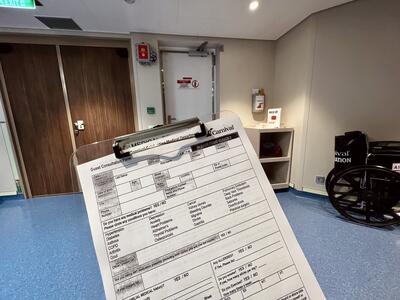
Further, pregnant passengers should take into account potential health risks while visiting numerous ports of call. One of the biggest health risks for Caribbean cruises, for example, is exposure to the Zika virus, which can cause birth defects. More obscure itineraries to destinations with risks of malaria or yellow fever - such as Africa, Asia, or South America - are also not recommended for pregnant passengers.
Choosing to cruise while pregnant means you are comfortable with the risks you'll be taking.
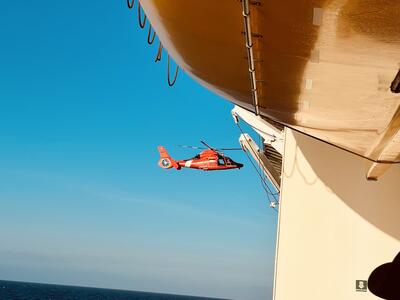
Whether you choose to cruise while pregnant is up to you; however, it’s not without its risks. Just as you could experience complications at home during your pregnancy, you also chance having pregnancy complications while cruising. For example, Royal Caribbean’s website reminds pregnant passengers to consider the risks of cruising while pregnant and to discuss these risks with their treating physician.
On Royal Caribbean’s website, the cruise line states, “There is no Obstetrician/Gynecologist available on the ship, and that pregnancies, when unstable and poorly controlled, are potentially life-threatening, especially without back up. A Guest may be at sea for several days without any immediate hospital and/or specialist back up, and that since the proposed itinerary is not within the U.S., and the availability of specialized shore side facilities can be problematic.”
If you have a high-risk pregnancy for any number of reasons, such as prior preterm labor or preexisting conditions, it might be advisable by your doctor not to cruise.
How can you minimize the risks of cruising while pregnant?
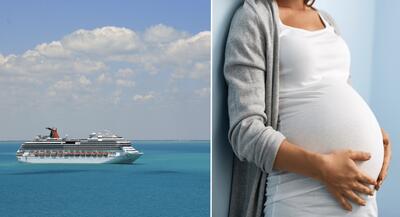
If you’re looking forward to a babymoon cruise, you’re not alone! Many women are able to successfully cruise during their pregnancy. Those with minimal risks and approval from their doctor are welcomed onboard cruise ships, as long as their pregnancy does not exceed 24 weeks.
There are some basic precautions you can take to minimize your risks while cruising. According to Celebrity Cruises, the ideal time for pregnant women to cruise is typically between 14 and 23 weeks during the second trimester. This is when most pregnant women have subsided morning sickness and rejuvenated energy before reaching the riskier third trimester.
Pregnant women should consider itinerary length and cruise destination as well. For instance, choosing a shorter itinerary helps minimize your risks compared to a longer itinerary with more sea days. Many cruise lines have short weekend sailings with three- or four-night itineraries for the perfect getaway.
On the other hand, a 14-night itinerary might not be the best choice, as you would be away from your medical team at home for an extended period. It would be wise to skip transatlantic sailings since you’d be at sea for long stretches. Choose a port-intensive itinerary instead that will keep you closer to shore each day helps minimize your risk.

Further, consider the availability of medical care for your itinerary destinations. It’s probably not a good idea to cruise in remote areas, such as Antarctica, due to the exorbitant distance to medical care in the case of an emergency.
Finally, make sure you purchase travel insurance. The additional protection will provide peace of mind that you won’t break the bank if you do have an emergency cruising while pregnant.


